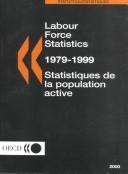| Listing 1 - 10 of 46 | << page >> |
Sort by
|

ISBN: 1280034629 9786610034628 9264088423 9264085661 Year: 2000 Publisher: Paris Cedex, France : OECD,
Abstract | Keywords | Export | Availability | Bookmark
 Loading...
Loading...Choose an application
- Reference Manager
- EndNote
- RefWorks (Direct export to RefWorks)
This annual edition of Labour Force Statistics provides detailed statistics on population, labour force, employment and unemployment, broken down by gender, as well as unemployment duration, employment status, employment by sector of activity and part-time employment. It also contains participation and unemployment rates by gender and detailed age groups as well as comparative tables for the main components of the labour force. Data are available for each OECD Member country and for OECD-Total, Euro zone and EU15. The time series presented in the publication cover 20 years for most countries.
Labor -- Europe -- Statistics. --- Labor supply -- Europe. --- Population --- Vital statistics
Book
ISBN: 2903148252 9782903148256 Year: 1982 Volume: 1 Publisher: Strasbourg : European Science Foundation,
Abstract | Keywords | Export | Availability | Bookmark
 Loading...
Loading...Choose an application
- Reference Manager
- EndNote
- RefWorks (Direct export to RefWorks)
migranten --- metropolen --- Alien labor --- Communism. --- Foreign workers --- Alien labor - Europe
Book
ISBN: 2903148309 9782903148300 Year: 1982 Volume: 2 Publisher: Strasbourg : ESF,
Abstract | Keywords | Export | Availability | Bookmark
 Loading...
Loading...Choose an application
- Reference Manager
- EndNote
- RefWorks (Direct export to RefWorks)
Alien labor --- Psychology --- Foreign workers --- Psychology. --- Alien labor - Europe - Psychology
Book
ISSN: 21059616 ISBN: 9782843033001 2843033004 Year: 2020 Publisher: Paris : La Dispute,
Abstract | Keywords | Export | Availability | Bookmark
 Loading...
Loading...Choose an application
- Reference Manager
- EndNote
- RefWorks (Direct export to RefWorks)
Temps, rythmes et intensité du travail sont des questions qui traversent depuis des siècles les sociétés occidentales. Cet ouvrage aborde les différents rythmes du labeur, du temps court de la journée à celui des saisons et de l'année, depuis le XIVe jusqu'à la fin du XIXe siècle. A rebours des idées convenues et des illusions statistiques, l'ambition est ici d'aborder les différentes temporalités du travail dans toute leur complexité. En variant les échelles temporelles et spatiales, en s'appuyant sur des reconstitutions de vies au travail, les auteur-e-s remettent en cause l'idée d'une évolution linéaire : lors de l'industrialisation, hommes, femmes et enfants ne travaillent pas nécessairement plus longtemps et l'intensification du travail précède parfois le machinisme. Cette perspective historique de longue durée nourrit les réflexions actuelles autour des temps du travail
Horaires de travail --- Travail --- Histoire. --- Hours of labor --- History --- History. --- Hours of labor - Europe, Western - History

ISBN: 2715710011 2715703252 2715703422 9782715703254 9782715710016 Year: 1980 Publisher: Paris: Anthropos,
Abstract | Keywords | Export | Availability | Bookmark
 Loading...
Loading...Choose an application
- Reference Manager
- EndNote
- RefWorks (Direct export to RefWorks)
Communism --- Press, Labor --- History --- Engels, Friedrich, --- Marx, Karl, --- Communism - History --- Press, Labor - Europe - History --- Engels, Friedrich, - 1820-1895 --- Marx, Karl, - 1818-1883

ISBN: 1843766183 9781843766186 Year: 2005 Publisher: Cheltenham Edward Elgar
Abstract | Keywords | Export | Availability | Bookmark
 Loading...
Loading...Choose an application
- Reference Manager
- EndNote
- RefWorks (Direct export to RefWorks)
Economic sociology --- Work and family --- Organizational change --- Sexual division of labor --- Hours of labor --- Part-time employment --- Telecommuting --- Quality of work life --- Work and family - Europe - Congresses --- Organizational change - Europe - Congresses --- Sexual division of labor - Europe - Congresses --- Hours of labor - Europe - Congresses --- Part-time employment - Europe - Congresses --- Telecommuting - Europe - Congresses --- Quality of work life - Europe - Congresses
Book
ISBN: 1461400848 1489992693 1280787562 1461400856 9786613697950 Year: 2012 Publisher: New York : Springer,
Abstract | Keywords | Export | Availability | Bookmark
 Loading...
Loading...Choose an application
- Reference Manager
- EndNote
- RefWorks (Direct export to RefWorks)
In Europe, the liberation of the serfs was a project initiated in 1806 with a scheduled completion date of 1810. It was obvious to those who planned the project that the liberation of the serfs involved a complete overhaul of agriculture as it was then known as Europe moved from feudalism to capitalism. For this reason, Prussia was careful in implementing the reform, and did not rush, after seeing the Kingdom of Westphalia perishing under its crushing debt accumulated in part from Napoleon’s failed Russian campaign. The basic hypothesis of this book is that slave labor can never be efficient and will therefore disappear by itself. However, this process of disappearance can take many years. For instance, two generations after the importation of slaves to North America had ended, the states still fought over the issue, and this despite the fact that Ely Whitney had invented the Cotton Gin in 1793 and already then made slavery in cotton production literally superfluous. While there have been several books on the economics of American slavery, few studies have examined this issue in an international context. The contributions in this book address the economics of unfree labor in places like Prussia, Westphalia, Austria, Argentina and the British Empire. The issue of slavery is still a hotly debated and widely studied issue, making this book of interest to academics in history, economics and African Studies alike.
Economics. --- Forced labor -- Europe -- History. --- Forced labor -- Europe. --- Slavery --- Slave labor --- Slaves --- Business & Economics --- Sociology & Social History --- Social Sciences --- Economic Theory --- Communities - Social Classes --- Economic aspects --- Emancipation --- Serfs --- Economic aspects. --- Management science. --- Economics, general. --- Serfdom --- Economic theory --- Political economy --- Social sciences --- Economic man --- Quantitative business analysis --- Management --- Problem solving --- Operations research --- Statistical decision

ISBN: 067444423X Year: 1992 Publisher: Cambridge, Mass. Harvard University Press
Abstract | Keywords | Export | Availability | Bookmark
 Loading...
Loading...Choose an application
- Reference Manager
- EndNote
- RefWorks (Direct export to RefWorks)
Migration. Refugees --- Sociology of minorities --- Europe --- Foreign workers --- Government policy --- Emigration and immigration --- Europe - Emigration and immigration. --- Europe - Emigration and immigration - Government policy. --- Alien labor - Europe. --- Alien labor - Government policy - Europe. --- Emigration and immigration. --- Government policy.
Book
ISBN: 9282686027 9789282686027 Year: 1994 Publisher: Luxembourg Office for official publications of the European communities
Abstract | Keywords | Export | Availability | Bookmark
 Loading...
Loading...Choose an application
- Reference Manager
- EndNote
- RefWorks (Direct export to RefWorks)
Sociology of minorities --- Sociology of work --- Labour economics --- European Union --- Foreign workers --- Europe --- Emigration and immigration --- Alien labor --- Congresses --- Emigration et immigration --- Congrès --- Alien labor - Europe - Congresses --- Europe - Emigration and immigration - Congresses

ISBN: 3110142740 3110142759 3110873508 9783110873504 9783110142747 9783110142754 Year: 1995 Volume: 68 Publisher: Berlin: de Gruyter,
Abstract | Keywords | Export | Availability | Bookmark
 Loading...
Loading...Choose an application
- Reference Manager
- EndNote
- RefWorks (Direct export to RefWorks)
Division of labor --- Industrial management --- Personnel management --- Division du travail --- Gestion d'entreprise --- Personnel --- Direction --- Labor, Division of --- Labor --- Economic specialization --- Europe --- Division of labor - Europe. --- Industrial management - Europe. --- E-books --- Personnel management - Europe.
| Listing 1 - 10 of 46 | << page >> |
Sort by
|

 Search
Search Feedback
Feedback About UniCat
About UniCat  Help
Help News
News